#Porcellionidae
Note
Hey, saw this little guy in my bathroom. Don't know if I poked it to death or it's playing possum, but it doesn't quite look like a silverfish, so I'm thinking it's a firebrat?

So this is actually an isopod.
This looks to me like Powder Blue Isopod aka Plum Woodlouse (Porcellionides pruinosus), Porecllionidae, which is originally from Europe, but has been introduced around the world.
110 notes
·
View notes
Text


Swift woodlouse / Porcellio laevis
16 notes
·
View notes
Text
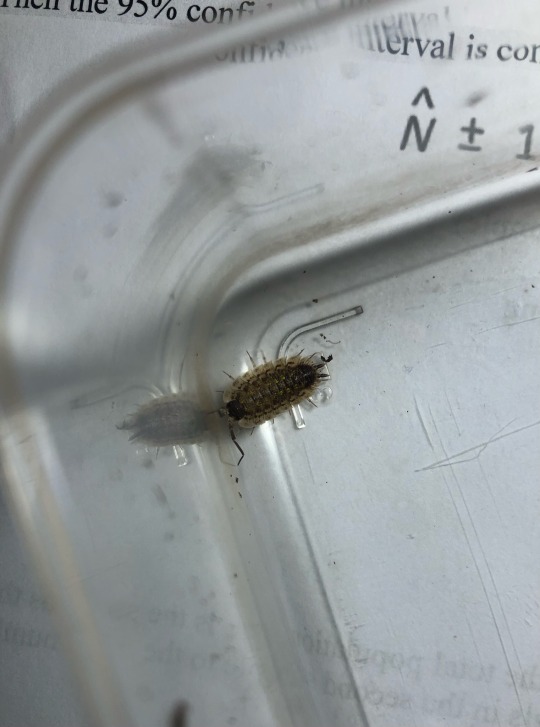
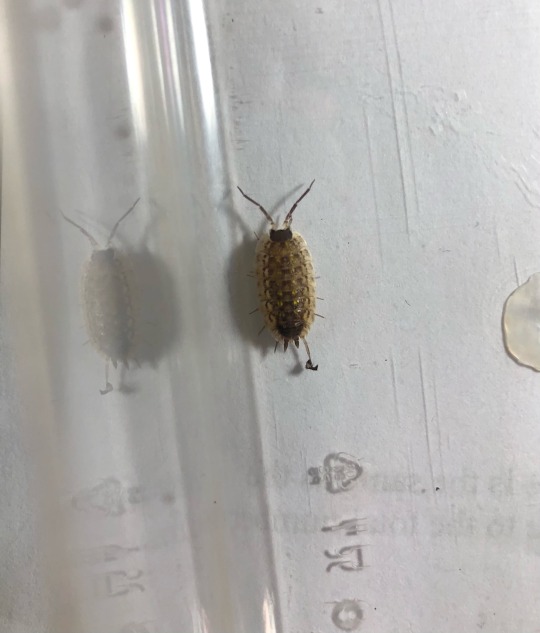
Porcellio spinicornis
Brickwork woodlouse
5 of November 2022 — New York, USA
Originally native to Europe, this species has become naturalized in North America. It can be distinguished from other woodlouse species by the dark ‘face’ and the dark almost-line it has running down its back with yellow mottled patterns on the sides of it. This pattern reminded someone of brickwork which is what inspired the name. They are nocturnal, and eat decaying plant matter. Unlike isopods in the family Armadillidae, brickwork woodlice cannot roll up into a ball.
This little friend was found in the restroom and released outside after I took pictures haha
#bugs#bugs i found#isopod#isopods#woodlouse#woodlice#Malacostraca#Isopoda#Porcellionidae#Porcellio#Porcellio spinicornis#original content
2 notes
·
View notes
Text
#2393 - Porcellio scaber - Common Rough Woodlouse


Woodlice have an astonishingly variety of common names, considering they're harmless detritivores. But then they are adorable little fuckers. Common names I've used myself include slater, sow bug, piggywig, and pill bug, but others include cheesy bug, butchy boy, chisel pig, rolypoly, granny grey and boatbuilder. Admittedly some of those are applied to species that can roll into a ball.
I'm surprised I haven't covered this species before - they're the most common woodlouse in urban areas in Australia. But they certainly didn't originate here - they were originally found in Europe but now enjoy a much wider distribution. It has also colonised North America, South Africa and other regions including the remote sub-Antarctic Marion island.
Only one subspecies, Porcellio scaber lusitanus, is currently considered valid.
Unlike the equally common Armadillidium woodlice, this species can't roll into a ball. Instead, when disturbed, they clamp down onto the surface and freeze in place. Interestingly, individuals vary widely in how long they'll stay frozen in place.
Porcellio scaber requires moist conditions to avoid drying out and dying, but is more tolerant of desication than some common species. These ones were in the woodshed at the Mill House.
Woodlice evolved from marine isopods and had moved onto the land at least as early as the Cretaceous period, but most likely did so during the Carboniferous. They're still one of very few crustacean lineages to have transitioned into a fully terrestrial enviroment.
When woodlice moult the back half is lost first, followed two or three days later by the front - quite different to most arthropods.
A female woodlouse will keep fertilised eggs in a marsupium on the underside of her body, where they hatch into offspring that look like small white curled-up woodlice. The mother then appears to give live birth to her offspring. A few species can reproduce asexually.
Pohokura, North Island, New Zealand
1 note
·
View note
Note
do you know if it's possible for p. scaber to hybridize with a. vulgare? I have a wild caught colony of vulgare and I threw one (1) female scaber in the mix I found in my bathroom and she's been gravid twice now. shes my only scaber (and she's very distinctive looking so i know it's the same one) so unless she's retained sperm from the wild for 2 different pregnancies idk what could be happening
not possible I think—the divergence between the families Porcellionidae and Armadillidiidae is on the order of some 100 million years old (well, a lot of the papers are probably pretty shaky but it’s Old) and besides their genitalia are pretty incompatible (believe me, I’ve seen them try it both ways to no results, male isopods are persistent and indiscriminate).
the other explanation is almost certainly the answer. I’ve had female isopods of multiple species give five, six clutches in isolation.
43 notes
·
View notes
Text


@rafael-satan submitted: recently i bought myself my first ever isopods, blue powder. and i have a question, can they roll up in a ball? i was trying to find any info about that, but only found that not all types can do that, nothing specific for them. (i love them any way, if they can or not, I'm just curious) and maybe there are any other things i need to know about this specific breed(?)
Pill woodlice (family Armadillidiidae) are the ones that can roll into a ball and powder blue isopods are in the family Porcellionidae. So no, they don't roll into a ball, but they are just as cute! Their care is about the same as any other common isopods one might keep, so it's pretty simple. The one thing I would say is make sure to offer them something with protein in addition to plant matter! I don't keep isopods anymore, but when I did, mine went absolutely bonkers over betta fish food flakes :)
139 notes
·
View notes
Text



SOUVENIR HAUL 5 - Him.
3 notes
·
View notes
Text
Update to last night's post. Did some more research on the unidentified isopod and the reddit post was actually correct on their ID (Google was just giving me bad results) , they are Cylisticus convexus. Again the orange uropods does not appear to be something entirely typical with this species.
Odd how both of these very different species have orange uropods, wonder if it's something in the environment causing it like high iron? Or all the pine needles?
Same pics again cuz why not

Both the ones I cought yesterday appear to be doing well. The P. Floria was out chilling on some bark I put in there.
Planning to set up some isopod potato traps later today in that area to see what all more can be found, hopefully some more P. Floria so I can set up a viable colony of them.
#ads_isopods#cylisticus convexus#porcellionidae floria#c. convexus#p. floria#isopod#isopod keeping#bug#bugs#bugblr#insectblr
12 notes
·
View notes
Photo

Taken 2021 16th November, fossils weren't the only things tucked in the rocks. Brickwork woodlice (Porcellio spinicornis) were hiding out from the cold present at the site. It's not surprising to find them there given their affinity for calcareous substrates. #animal #animals #djur #wildlife #natur #naturliv #nature #crustacean #crustaceans #fauna #arthropods #arthropod #isopod #isopods #leddjur #woodlouse #woodlice #terrestrialisopods #kräftdjur #gråsugga #gråsuggor #animalia #arthropoda #crustacea #isopoda #oniscidea #porcellionidae #porcellio #porcelliospinicornis #brickworkwoodlouse (at Stenbrottet I Hällekis) https://www.instagram.com/p/CYYFfIigCr1/?utm_medium=tumblr
#animal#animals#djur#wildlife#natur#naturliv#nature#crustacean#crustaceans#fauna#arthropods#arthropod#isopod#isopods#leddjur#woodlouse#woodlice#terrestrialisopods#kräftdjur#gråsugga#gråsuggor#animalia#arthropoda#crustacea#isopoda#oniscidea#porcellionidae#porcellio#porcelliospinicornis#brickworkwoodlouse
0 notes
Photo

15 notes
·
View notes
Note
what species of isopod that you keep do you find is most active or visible? i've been considering starting an isopod culture of my own but i'd really like to be able to see them moving around and doing their thing and i'm really not sure what species to go for for that! i'd potentially just scoop up some wild isopods to start from (my area has quite a few species, including some trichoniscidae, oniscidae, armadillidiidae, trachelipidae, porcellionidae, and cylisticidae, if that is at all helpful) but i'd be open to buying some if you'd recommend a different species than what i have available to me :] ty for posting about bugs and getting me interested in these little guys, i think i'd still be far more afraid of them if i hadn't stumbled onto your blog!!
isopods as a rule are nocturnal, secretive creatures, and generally a hidden isopod is a happy isopod. they don’t want you watching them! constantly roving isopods might mean an enclosure is inappropriate or the animals are overcrowded. if you must see a pet to enjoy it, I really wouldn’t recommend starting with isopods.
however, some species are relatively active, such as Porcellionides pruinosus. these are quick, mobile isopods that often come out during the day, especially if you leave out some tasty protein-based foods like fish food or dog kibble to attract them. Philsocia muscorum are another active species that I even find moving diurnally in the wild, but they are notoriously fragile in captivity and I do not recommend them for the beginner, even if they’re found locally.
if you are awake at night a lot, and don’t mind viewing isopods in the dark, then any species will work, really! dim white lights or red night lights are usually not enough to scare them into hiding, so you’ll be able to observe any species as they do their thing at night. every species I have is out and about after dark.
40 notes
·
View notes
Note



Found these two massive isopods today!
I'm kind of tempted to put them with the ones in my terrarium but they're a different species (the other ones I have are a wild type that can roll up and are smaller and prettier colors wise) and I'm afraid of them interbreeding and causing infertile offspring :p These and the other species are often in the same space together in the wild so they might be fine?? idk
Porcellio laevis male/female pair. except for a few weird European species of Armadillidium, almost all isopod species are not known to be reproductively compatible with others, even somewhat close relatives such as members of the same genus. your laevis will definitely not be able to mate with the A. vulgare (I’m guessing that’s what the others are) since they aren’t even in the same family (Porcellionidae, Armadillidiidae).
especially in the part of North America where I live, the handful of introduced species aren’t closely related enough to hybridize. two common species in two genera Porcellio (scaber, spinicornis) & Armadillidium (vulgare, nasatum) are incapable of hybridization even though they each share a genus, and will regularly be found in the wild next to one another with no hybrids at all.
that’s not to say that they won’t try… male isopods are very persistent and will attempt mating with just about any isopod they can get their little claws on. I’d say the only risk of mixing species is that laevis are rather aggressive and won’t hesitate to eat another molting isopod, so offer some sort of protein; a tiny pinch of fish flakes every few days (if they eat it completely) should work.
56 notes
·
View notes
Photo

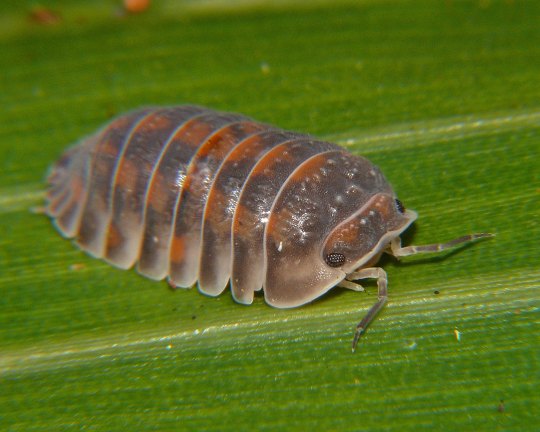
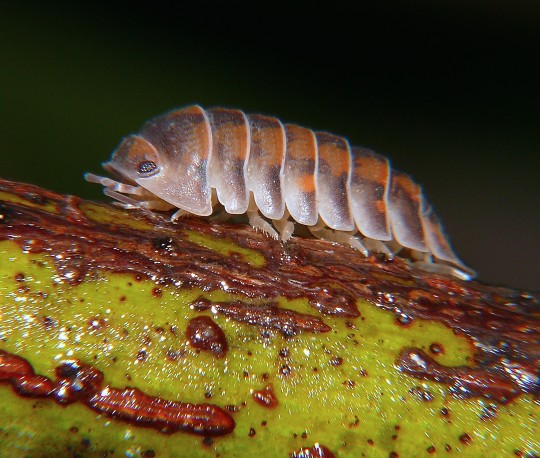



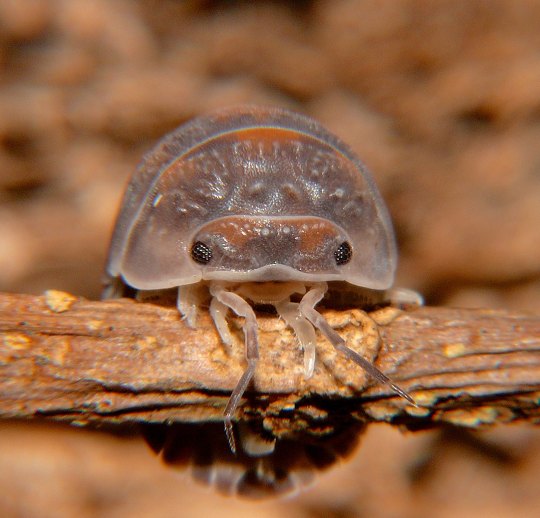


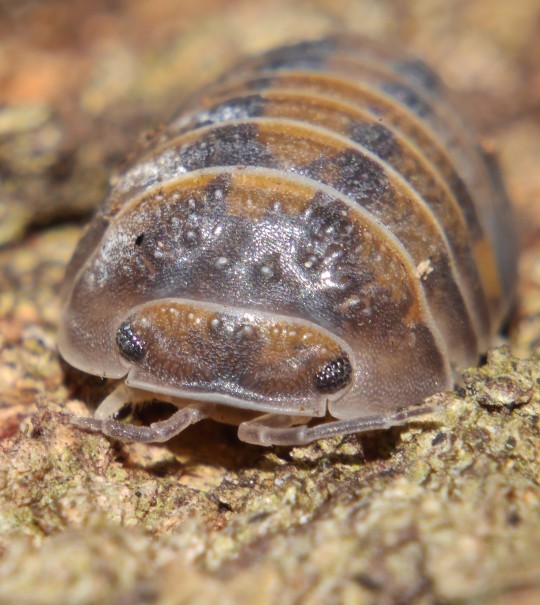
Rainforest tree slater, Porcellio sp., Porcellionidae, Isopoda
Photographed in Airlie Beach Rainforest, Australia by Steve & Alison1
Photos shared with permission; do not remove credit or re-post!
#animals#curators on tumblr#bugs#isopod#woodlouse#tree slater#rainforest tree slater#crustaceans#one nice bug#look at those angry little faces#spectacular
2K notes
·
View notes